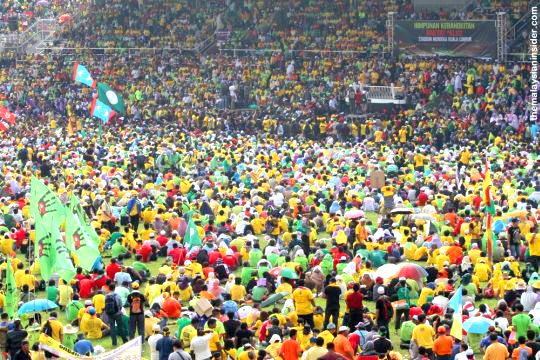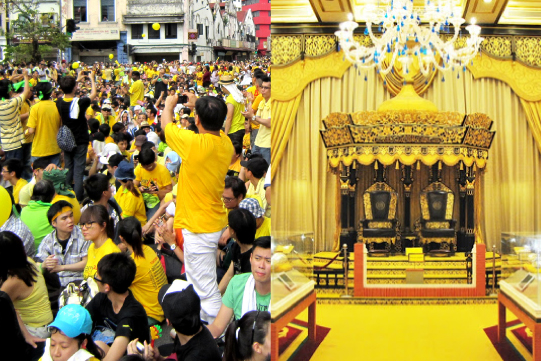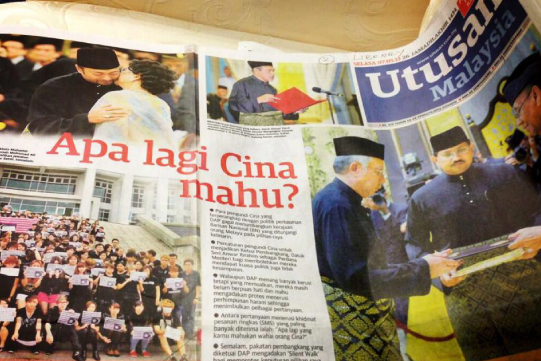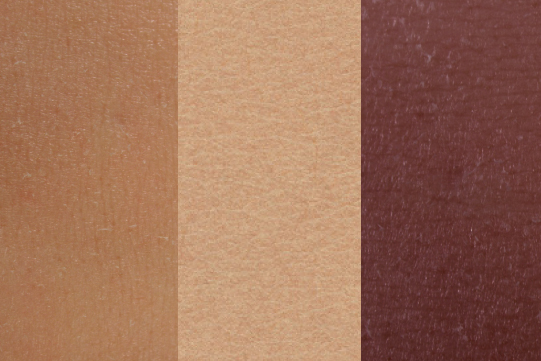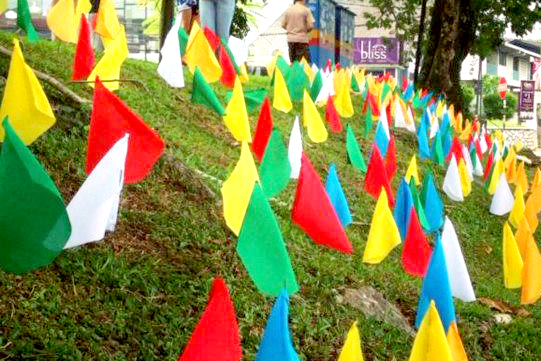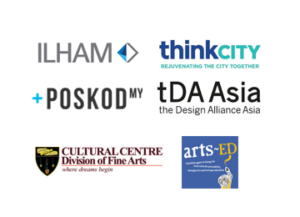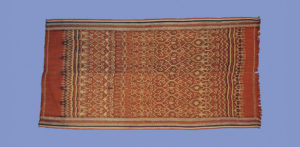Competing Visibilities (Part 1) – The Politics of Colour
By Tan Zi Hao, 2013
Protestors dressed in yellow, green, red, orange, and black for Himpunan Kebangkitan Rakyat #KL112, held on 12 January 2012. Photo credit: themalaysianinsider.com
Colour has in times of emerging political upheaval played a role in ideological identification: yellow for Bersih; green for Anti-Lynas; red for Royalti Kelantan; orange for Anti-Felda Global Venture Holdings; black for 1Black Malaysia or Blackout 505. The harmless appearance of colour has proven itself useful as a symbolic instrument of resistance. Colour speaks without talking, and without making direct graphical or typographical remarks. Colourful parades, from Bersih 3.0 to #KL112, are a form of hitting without bruising, a signifying gesture, a movement that does not strike but whose presence makes opponents flinch. Simplicity and applicability are the natural prowess of colour. Being colour-coded is the only obligation and all else is reduced to this last sign and significance.
The underlying universalism of colour exposes itself to ideological contestation. What a colour represents today may represent something else tomorrow. For instance, the colour yellow recently dignified by the Bersih movement of mass protest as symbolising “cleanliness” had once suffered from the infamy of terms such as “yellow journalism” or “yellow jokes” (黄色笑话; “dirty” jokes). Furthermore, in traditional feudal context, yellow is the colour of royalty and aristocracy. From a sexually, sensationally charged and undemocratic colour, Bersih’s yellow comes out representing the opposite in its entirety – a colour of fairness, cleanliness and of the rakyat (however exclusive is this term). [1]
Colour conventions were overturned. The consistent use of yellow in Bersih 2.0 and Bersih 3.0 was organic rather than imposed. [2] This can be read as a form of democratic mobilisation, where colour amplifies and connects disparate energies for more effective and spatially expansive citizen action – a hoped-for catalyst in a suffocating political environment. But no reference is eternally fixed. At the height of the momentum for Bersih 3.0 (28 April 2012), two exhibitions remarkably blanketed in yellow were held simultaneously in Kuala Lumpur: “Pameran Raja Kita” in the former Istana Negara [3] and “Pameran Kesultanan Perak” in Galeri Petronas [4]. At moments of anticipation and speculation, any showcase of yellow inevitably turns into a political statement. [5] Ideological indifference or calculated coincidence? The tenacious disregard of political climate was perhaps an arrogant display of power served to remind the public about the true owners of yellow – the royals, a contemporary symbolism of Malay feudal aristocracy.
Contesting yellows: is yellow the rakyat’s colour or the Royal’s colour, or both? Photo credit: Tan Zi Hao (left); kakiberangan.blogspot.com (right)
Heightened ideological contestation on colour politics fosters a battlefield that is ever more symbolic and ocularcentric, or the privileging of sight over other senses. Here, colour plays the game of unification by synthesising multiplicity. Ocularcentrism assassinates multiplicity but spotlights the visibility of difference, in other words, shades are negligible but hues reinforce difference. [6] As yellow hovers between different moral positions, the interstitial multiplicity is deemed politically insignificant. What one could learn from this ocularcentric paradigm is that visibility equals power. For social movements such as Bersih or Anti-Lynas, colour is a convenient unifying device to amass support. However, shades are sublated into a singular hue, and the marginals and minorities are often sacrificed temporarily as a compensation for greater visibility. [7]
The play of colour is mundane and historically old. More familiar to Malaysians is the politics of skin colour, or, the politics of race. Identification of the skin marks the epitome of ocularcentrism because the outer layer is the final screen relinquishing all curiosity of the flesh. The skin is the limit; its colour is the totality. Colonial census-cum-colourist[8] dictatorship: [9] what you are is what you appear to be – visibility endorses the absolute truth, no elaboration beyond pigments. While racist politics beset the country for decades, one could perceive the emergent colourful camaraderie of oppositional politics as a form of counterstatement. What is apparent in this struggle against the dominant power structure is a competition of visibilities. And as Malaysia slumps into ocularcentrism, right-wing colourists are expected victors in the game of visibility since nothing is more visible than the skin colour.
Transitional period breeds opportune conservatism. With escalating racial debates since the 13th General Election, the politics of colour shifted from emphasis of ideological colour codes to physical skin colour, and agreeably reverts to the ethnocentric right. It is not an overstatement to say that racial politics has achieved a new touchstone since the election, primarily due to Barisan Nasional’s post-election response, and also the general xenophobia amid deepening suspicion of the electoral process. In an attempt to assuage anxieties caused by its decline, leaders of Barisan Nasional resorted to racialising the political result, naming it a consequence of “Chinese tsunami”, dismissing the more deep-rooted but less visible urban-rural class-based division. This was soon followed by an equally racial statement published by the UMNO-controlled newspaper Utusan Malaysia “Apa lagi Cina mahu?” (What else do the Chinese want?).
The controversial headline published by Utusan Malaysia on 7 May 2013, two days after the 13th General Election in Malaysia. Photo credit: josephinemock.wordpress.com
The thematic shift to skin colour takes on a larger scale and is not restricted to the ruling party. Left-inclined opposition parties and the public at large have unconsciously jumped onto the bandwagon in claiming that dark-skinned voters (with a presumably “foreign” physiognomy) are either immigrants or illegitimate holders of Malaysia’s identity card. More radically, A.B.U. (Anything But UMNO, or, Asalkan Bukan UMNO) even initiated “Squad T.A.H.A.N.” (Team Abu Halang Asing Ngundi) to prevent potential sponsored immigrants from voting during the polling day.[10] But to take the skin as the arbiter of identity is to share the same racist-colourist lens they first wished to obliterate. The xenophobic attitude cultivated throughout the election period was already a testament to Barisan Nasional’s premature victory in sustaining the politics of race at two levels. The first level of visibility, where skin colour overruled ideological colour codes. The second level of visibility, where xenophobia constituted a magnified sense of distinction via skin colour, which in turn further naturalised institutional racism and legitimised race-based political parties.
Racial politics: skin colour can potentially dictate or limit social mobility. Photo credit: Tan Zi Hao
In this landscape of competing visibilities, Barisan Nasional gets the upper hand. Colourism [11] belittles ideological contestation: an anti-ideology, since, if only the utmost visible matters most, ideation is superfluous. Racial consciousness undermines class consciousness;[12] insofar as the notion of class remains invisible, the ruling elites will continue to control the capital redistribution of the middle-class and the rural poor under the rubrics of one’s own skin colour – an empty signifier nonetheless but a masking of real power. [13]
One is in need of brighter colours for greater visibility. During the election month, the Malaysian Spring initiative has created vibrant spectacles which, unlike Bersih’s yellow or Anti-Lynas’s green, defied singularity and welcomed multiplicity.[14] Seen from up close, unfettered colours develop into hypervisibility, and to each its own presence: hues and shades, mix and match. Such visual tactic adheres to the Spring’s principle, it encapsulates inclusiveness and articulates a commitment towards democracy. Assembled in simple steps, the Spring encourages mass duplication and participation. The little flags are flowers that do not threaten but seduce and overwhelm, burgeoning at different locations, resembling waves of uprising sans human. This absence of human does not reduce its capacity but instead adds to the mystery of its symbolic circulation: Who are the makers? For whom do they speak? How many of them? What do the colours signify? [15]
Malaysian Spring first started in Bangsar. It went viral after a few days, in part due to its ambiguous nature and the momentum of election. Photo credit: Malaysian Spring
Malaysia’s visual culture is embarking a strategic reformulation of visual methodologies. The competition for visibility runs fierce, and thus far, as one witnesses the return of the political left, denominations like “fairness” (Bersih’s yellow or Blackout 505’s black, for the lack thereof), “equality” (Royalti Kelantan’s red or feminist purple), and “nature” (Anti-Lynas’s green) resurface. The challenge has been to make these colour-coded conceptions more visible than “race”, so to bypass skin colour determinism and to start our palette afresh.
Endnotes:
[1] The colour yellow can also be attributed to the yellow ribbon as a symbol of freedom, but it is doubtful whether the general public is at all conscious about this association.
[2] Bersih’s organising committees admitted that there was a thought of changing the colour yellow in a post-mortem meeting. The plan did not proceed as the public had already strongly associated the colour to the movement.
[3] “Pameran Raja Kita” opened on 16 April 2012 at Istana Negara (Royal Palace). It was the first time the palace was open to the public. The exhibition runs until today, and with the construction of a new palace complex along Jalan Duta, the former palace has been converted into Muzium DiRaja Istana Negara (National Palace Royal Museum).
[4] “Pameran Kesultanan Perak” (The Perak Sultanate Exhibition) was an exhibition held in conjunction with the 84th birthday of the D.Y.M.M. Paduka Seri Sultan Perak, Sultan Azlan Muhibbuddin Shah Ibni Almarhum Sultan Yussuf Izzuddin Shah Ghafarullahu-Lah. The exhibition began on 26 April 2012 at Galeri Petronas, with the aim to “increase public awareness and understanding of the Perak Royal Institution, its historical background and the significant role it played in the formation of the state.” See “Past Exhibition: Pameran Kesultanan Perak – The Perak Sultanate Exhibition,” Galeri Petronas (April 2012), http://www.galeripetronas.com.my/pages/PastExhibition.aspx?MenuId=2&SubMenuId=7 [accessed 10 July 2013].
[5] Yellow has become rather seditious, especially since Bersih 2.0 (9 July 2011). Prior to the Bersih 2.0 rally, Bersih’s official yellow t-shirts were banned by the Ministry of Home Affairs and many were also detained for wearing yellow. See The Guardian, “Malaysia arrests 14 for ‘Bersih’ protest T-shirts,” The Guardian (June 2011), http://www.guardian.co.uk/world/2011/jun/29/malaysia-arrests-bersih-t-shirts [accessed 10 July 2013]; Clara Chooi, “Pakatan condemns Bersih 2.0 ban,” The Malaysian Insider (July 2011), http://www.themalaysianinsider.com/malaysia/article/pakatan-condemns-bersih-2.0-ban [accessed 10 July 2013].
[6] Specific to this discussion, “difference” refers to a situation of political variation within which different subjects can be hostile to one another, whereas “multiplicity” refers to a situation of political variety or diversity within which different subjects may share similarities.
[7] Despite Bersih’s focused objective, there is a diversity of different reasons of attending the rally. Some agreed to all its demands; some disagreed but were there for solidarity; some were there for the festivity; some were simply curious. It is undeniable that there were many first-time protestors among the crowd. Yet, these diverse “shades” of yellow were often perceived as a fixed singular sign by which political variety was ignored for greater visibility: forget the naysayers, the people are all here for Bersih and only Bersih.
[8] The term “colourist” or “colourism” is used in this discussion merely to emphasise on the determinism of skin colour in racial politics. However, it must be recognised that racial politics does not depend solely on the colour of skin.
[9] Classification based on skin colour and ethnicity has a long history in colonialism. For a classic study on racial classification in colonial census in Malaysia, see Charles Hirschman, “The Meaning and Measurement of Ethnicity in Malaysia: An Analysis of Census Classifications,” Journal of Asian Studies, 46 (1987), pp. 555–582.
[10] A.B.U. chairperson Haris Ibrahim was aware of the underlying problem of Squad T.A.H.A.N. but has remained insistent on its operation: “…give us an alternative plan that has a realistic chance of preventing this fraud on the rakyat on polling day, and ABU will call this off. Until then, Ops TAHAN goes on.” See Haris Ibrahim, “Thanks for the coffee, now let’s get Ops TAHAN on,” The People’s Parliament (April 2013), http://harismibrahim.wordpress.com/2013/04/13/thanks-for-the-coffee-now-lets-get-ops-tahan-on/ [accessed 12 July 2013].
[11] See Endnote 8.
[12] While race and class influence one another in Malaysia’s political discourse, their complicated interaction is always downplayed by the former. For a study on the conflation of race and class, see David Brown, “Class, state and ethnic politics in Peninsular Malaysia,” in The State and Ethnic Politics in Southeast Asia (London and New York: Routledge, 1994), pp. 206–257.
[13] For a semiotic perspective on race, see especially Homi Bhabha, “The other question: the stereotype and colonial discourse,” Screen 24 (1983), pp. 18–36; Stuart Hall, “Race: The Floating Signifier,” directed by Sut Jally (Media Education Foundation, 1997).
[14] From Malaysian Spring’s official website: “Malaysian Spring is a rakyat effort to spread the message of hope and getting people to participate in the process of change. Why plant ‘flowers’? It is a simple and small gesture. A peaceful act and it brings beauty into our streets and neighbourhoods” [my emphasis]. Visit http://www.malaysianspring.com/ for more information.
[15] The anonymity of this viral Malaysian Spring movement has in fact aroused suspicion from the authority. See Farik Zolkepli and Austin Camoens, “GE13: Police identify group planning Malaysian Spring, says deputy IGP (Updated),” The Star Online (May 2013), http://www.thestar.com.my/story.aspx?file=%2f2013%2f5%2f4%2fnation%2f20130504123504&sec=nation [accessed 12 July 2013]. The initiator of the movement Ng Seksan has however clarified that the movement is about having hope for a better Malaysia. For his statement, see Emily Ding, “ ‘Malaysian Spring’ activist denies demonstration plot,” The Malaysian Insider (May 2013), http://www.themalaysianinsider.com/malaysia/article/malaysian-spring-activist-denies-demonstration-plot [accessed 12 July 2013].


